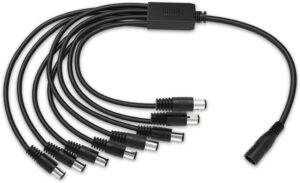
Global Positioning System (GPS) antennas are crucial components in navigation and tracking systems. These devices enable accurate positioning by receiving signals from satellites in orbit. Understanding the functionality, GPS antenna types, and applications is essential for optimizing navigation systems across industries.
What is a GPS Antenna?
A GPS antenna is a specialized device designed to receive radio signals transmitted by GPS satellites. These signals carry precise time and location information, which is essential for determining accurate positioning on Earth. The antenna’s role is to capture these signals and transmit them to a GPS receiver for processing.
GPS antennas operate within a specific frequency range, typically around 1575.42 MHz (L1 band). High sensitivity, low noise, and effective filtering of unwanted signals are critical characteristics for optimal performance.
Key GPS Antenna Types
The choice of antenna significantly affects the performance of a GPS system. Below are the primary GPS antenna types and their distinct features:
1. Patch Antennas
Patch antennas are flat and compact, making them suitable for use in portable devices such as smartphones and GPS trackers. They are low-profile and often integrated into devices requiring minimal space. Despite their small size, patch antennas offer reasonable performance, especially in environments with a clear view of the sky.
2. Helix Antennas
Helix antennas feature a spiral design and are commonly used in handheld GPS devices. They provide excellent signal reception, even in challenging environments like urban areas or dense forests. These antennas are often preferred for outdoor activities such as hiking or geocaching due to their reliable performance.
3. Chip Antennas
Chip antennas are extremely small and are often used in compact devices such as smartwatches and GPS-enabled wearables. Their miniature size makes them ideal for applications where space is limited. However, they may have reduced performance compared to larger antenna types.
4. Active Antennas
Active antennas incorporate an amplifier to boost weak signals. These are widely used in systems where the GPS receiver is located far from the antenna, such as in vehicles or marine applications. The integrated amplifier ensures that signals reach the receiver without significant degradation.
5. Internal Antennas
GPS internal antennas are built directly into devices, such as smartphones and tablets. They are designed to be compact and lightweight, providing convenience without the need for external components. Internal antennas offer sufficient performance for most consumer-grade applications but may struggle in environments with signal obstructions.
Applications of GPS Antennas
Automotive Industry
GPS antennas play a vital role in vehicle navigation systems, enabling real-time location tracking and turn-by-turn navigation. They are also used in advanced driver-assistance systems (ADAS) for functions like collision avoidance and autonomous driving. Reliable GPS signal reception ensures precise positioning, enhancing the overall driving experience.
Aviation and Marine
In aviation, GPS antennas are critical for navigation and flight management systems. They help pilots determine their exact position, altitude, and speed, ensuring safety and efficiency. Similarly, marine vessels rely on GPS antennas for navigation, route planning, and search-and-rescue operations.
Geospatial Applications
Surveying, mapping, and construction industries use high-precision GPS systems for geospatial data collection. GPS antennas with advanced features like multi-frequency capabilities enable accurate measurements, even in remote locations. These antennas are essential for creating detailed maps and models.
Consumer Electronics
Smartphones, fitness trackers, and smartwatches often include GPS internal antennas to provide location-based services. These devices use GPS data for navigation, fitness tracking, and social networking applications. The integration of internal antennas into consumer electronics has revolutionized how people interact with technology.
Agriculture
Precision agriculture relies on GPS antennas for tasks like field mapping, yield monitoring, and autonomous machinery guidance. These applications require high-accuracy antennas to optimize productivity and minimize resource usage. GPS technology helps farmers make data-driven decisions for efficient operations.
Factors to Consider When Choosing a GPS Antenna
1. Application Requirements
The intended application largely determines the type of GPS antenna needed. For instance, a compact GPS internal antenna may suffice for consumer devices, while high-precision patch or helix antennas are necessary for surveying or industrial applications.
2. Environmental Conditions
Environmental factors, such as obstructions or interference, can affect GPS signal quality. Active antennas with built-in amplifiers are ideal for challenging environments where weak signals may be a concern. Helix antennas are also suitable for areas with dense foliage or urban structures.
3. Frequency Compatibility
Most GPS applications use the L1 frequency band, but some advanced systems operate on additional bands like L2 and L5. Multi-frequency antennas provide better accuracy and faster signal acquisition, making them ideal for professional and industrial use.
4. Durability and Build Quality
For outdoor and industrial applications, durability is a key consideration. Antennas with robust construction and resistance to water, dust, and extreme temperatures are essential for reliable performance in harsh environments.
5. Cost and Integration
The cost of the antenna and its compatibility with the system should align with the project’s budget and requirements. Compact and cost-effective options like chip or GPS internal antennas are suitable for consumer-grade applications, while specialized antennas are necessary for professional use.
Optimizing GPS Antenna Performance
To ensure reliable signal reception and optimal performance, proper installation and positioning of the GPS antenna are crucial. Here are some tips:
- Clear View of the Sky: Place the antenna in a location with minimal obstructions to maximize signal reception. Avoid areas blocked by buildings, trees, or metallic structures.
- Correct Orientation: Align the antenna to its optimal position as specified by the manufacturer. For example, patch antennas perform best when facing the sky directly.
- Avoid Interference: Keep the antenna away from sources of electromagnetic interference, such as power lines or electronic devices. Proper shielding and grounding can also help reduce interference.
- Regular Maintenance: Inspect the antenna for physical damage or wear and clean it periodically to ensure long-term performance.
Conclusion
GPS antennas are indispensable in modern navigation and tracking systems. Understanding GPS antenna types, their applications, and selection criteria helps optimize system performance. From compact GPS internal antennas in consumer electronics to high-precision options in industrial systems, these devices continue to play a pivotal role in enhancing navigation accuracy. By selecting the right antenna and maintaining it properly, you can achieve reliable and precise positioning across various applications.





